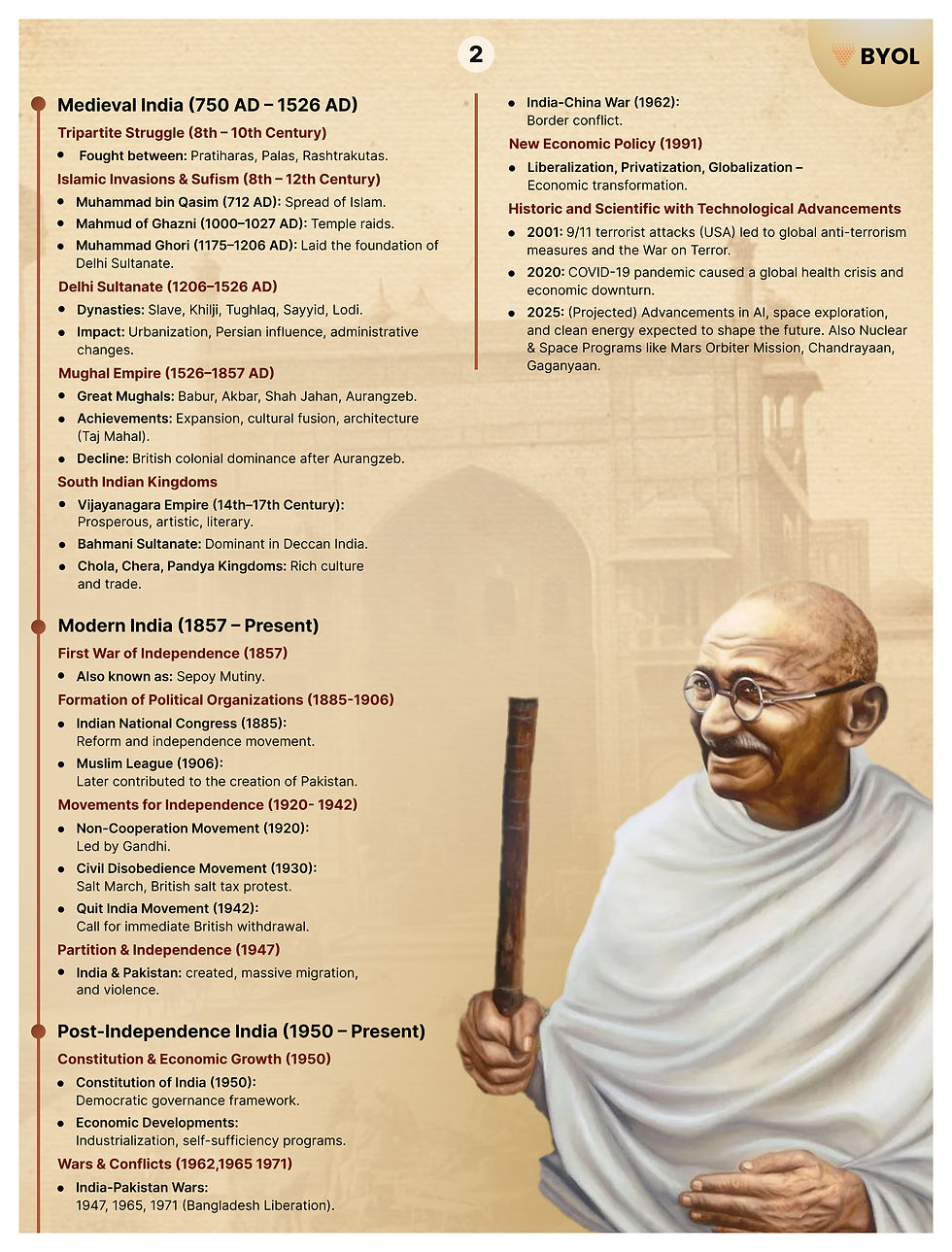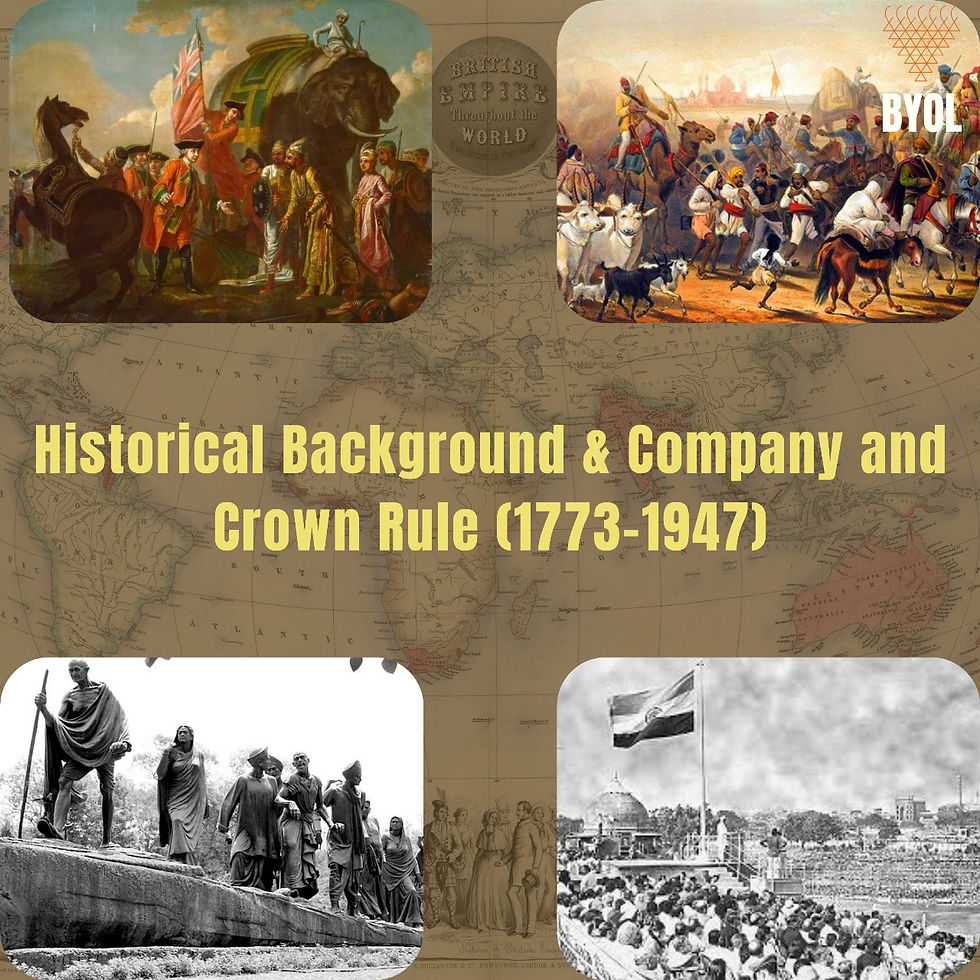Chronological Journey of Indian History: From Prehistoric Times to Modern Era
- Nancy Sharma

- Mar 2
- 3 min read
Updated: Mar 3
Prehistoric India (Before 4000 BC) – The Earliest Civilizations:
Human Evolution & Settlement
Homo Erectus: Present ~2 million years ago
Homo Sapiens: Arrived ~70,000 BC (hunter-gatherers)
Early Tribal Inhabitants
Naga (NE India), Santhal (East), Bhil & Gond (Central), Toda (South)
Languages: Austric, Pre-Dravidian (Munda, Gondvi)
Stone Age (2M BC – 1500 BC) – Evolution of Tools & Lifestyle
Paleolithic Age (2M – 10,000 BC) – Old Stone Age
Discovery of fire, cave dwellings, hunting
Important Sites: Bhimbetka, Hunsgi, Narmada Valley
Mesolithic Age (10,000 – 8,000 BC) – Transition Period
Microlithic tools, domestication of animals
Sites: Brahmagiri, Gujarat, Narmada Valley
Neolithic Age (8000 – 2000 BC) – Agricultural Revolution
Farming, pottery, permanent settlements
Major Sites: Mehrgarh, Burzahom, Chirand
Chalcolithic Age (4000 – 1500 BC) – Copper Age
Early urbanization, use of copper & bronze
Key Sites: Indus Valley Civilization (Harappa, Mohenjo-Daro, Lothal)
Iron Age (1500 – 200 BC) – Vedic Age & Rise of Empires
Vedic Civilization (1600 – 600 BC)
Iron tools, Rigveda & other Vedic texts
Rise of Mahajanapadas (16 Kingdoms)
Major Powers: Magadha, Kashi, Kuru, Avanti
Foreign Invasions
Persian (6th Century BC), Alexander’s invasion (327 BC)
Mauryan Empire (321 – 185 BC) – First Great Indian Empire
Key Rulers
Chandragupta Maurya – Founder, defeated Seleucus
Ashoka – Kalinga War, Spread of Buddhism
Ashoka’s Contributions
Rock edicts, Dhamma policy, Buddhism to Sri Lanka & SE Asia
Decline
Rise of Indo-Greeks, Sakas, Kushanas (78 AD)
South Indian Kingdoms (300 BC – 300 AD) – Sangam Age
Three Major Kingdoms: Cholas, Cheras, Pandyas
Trade with Romans & SE Asia
Tamil Literature Flourishes
Gupta Empire (300 – 800 AD) – Golden Age of India
Scientific & Cultural Achievements
Aryabhata – Concept of Zero, Astronomy
Nalanda University – Learning hub
Ajanta & Ellora Caves – Art & architecture
Key Rulers
Chandragupta I – Founder
Samudragupta – Military conquests
Chandragupta II (Vikramaditya) – Promoted arts & literature
Decline
Hunas invasion, rise of Rajputs, Pallavas, Chalukyas
Post-Gupta Period (700 AD onwards) – Rise of Regional Kingdoms
Harshavardhana (606 – 647 AD) – Last Great Hindu King
South Indian Powers: Pallavas, Chalukyas, Rashtrakutas
Fragmentation of Central Rule
Summary:
Period | Key Features | Important Sites/Kingdoms |
Paleolithic | Fire, Hunting | Bhimbetka, Narmada Valley |
Mesolithic | Domestication, Microliths | Brahmagiri, Gujarat |
Neolithic | Agriculture, Wheel | Mehrgarh, Burzahom |
Chalcolithic | Copper Age | Indus Valley Civilization |
Iron Age | Vedic Age, Mahajanapadas | Magadha, Nanda Empire |
Mauryan Empire | Ashoka, Buddhism | Pataliputra |
Gupta Empire | Golden Age, Science | Nalanda, Ajanta |
4. Medieval India (750 AD – 1526 AD)
Tripartite Struggle (8th – 10th Century)
Fought between – Pratiharas, Palas, Rashtrakutas
Islamic Invasions & Sufism (8th – 12th Century)
Muhammad bin Qasim (712 AD) – Spread of Islam
Mahmud of Ghazni (1000–1027 AD) – Temple raids
Muhammad Ghori (1175–1206 AD) – Laid the foundation of Delhi Sultanate
Delhi Sultanate (1206–1526 AD)
Dynasties – Slave, Khilji, Tughlaq, Sayyid, Lodi
Impact – Urbanization, Persian influence, administrative changes
Mughal Empire (1526–1857 AD)
Great Mughals – Babur, Akbar, Shah Jahan, Aurangzeb
Achievements – Expansion, cultural fusion, architecture (Taj Mahal)
Decline – British colonial dominance after Aurangzeb
South Indian Kingdoms
Vijayanagara Empire (14th–17th Century) – Prosperous, artistic, literary
Bahmani Sultanate – Dominant in Deccan India
Chola, Chera, Pandya Kingdoms – Rich culture and trade
5. Modern India (1857 – 1950)
First War of Independence (1857)
Also known as – Sepoy Mutiny
Formation of Political Organizations ( (1885-1906)
Indian National Congress (1885) – Reform and independence movement
Muslim League (1906) – Later contributed to the creation of Pakistan
Movements for Independence (1920- 1942)
Non-Cooperation Movement (1920) – Led by Mahatma Gandhi
Civil Disobedience Movement (1930) – Salt March, British salt tax protest
Quit India Movement (1942) – Call for immediate British withdrawal
Partition & Independence (1947)
India & Pakistan created, massive migration, and violence
6. Post-Independence India (1950 – Present)
Constitution & Economic Growth (1950)
Constitution of India (1950) – Democratic governance framework
Economic Developments – Industrialization, self-sufficiency programs
Wars & Conflicts (1962,1965 1971)
India-Pakistan Wars – 1947, 1965, 1971 (Bangladesh Liberation)
India-China War (1962) – Border conflict
New Economic Policy (1991)
Liberalization, Privatization, Globalization – Economic transformation
Historic and Scientific with Technological Advancements
2001 – 9/11 terrorist attacks (USA) led to global anti-terrorism measures and the War on Terror.
2020 – COVID-19 pandemic caused a global health crisis and economic downturn.
2025 – (Projected) Advancements in AI, space exploration, and clean energy expected to shape the future. Also Nuclear & Space Programs like Mars Orbiter Mission, Chandrayaan, Gaganyaan






Comments